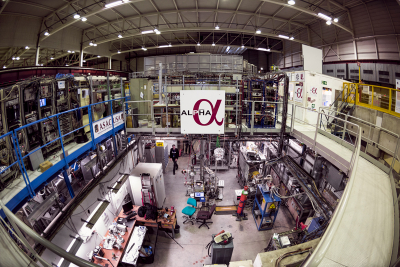
The ALPHA experiment at CERN’s Antiproton Decelerator has reported the first observation of the hyperfine structure of antihydrogen, the antimatter counterpart of hydrogen, using microwave spectroscopy. These findings (published in Nature) point the way to ever more detailed analyses of the structure of antihydrogen and could help understand any differences between matter and antimatter.
The researchers conducted the microwave spectroscopy measurements on homemade antihydrogen atoms, which drive transitions between different energy states of the anti-atoms. They could in this way improve previous measurements by identifying and measuring two spectral lines of antihydrogen.
In 2012, the ALPHA experiment demonstrated for the first time the technical ability to measure the internal structure of atoms of antimatter. In 2016, the team reported the first observation of an optical transition of antihydrogen. By exposing antihydrogen atoms to microwaves at a precise frequency, they have now induced hyperfine transitions and refined their measurements. The team were able to measure two spectral lines for antihydrogen, and observe no difference compared to the equivalent spectral lines for hydrogen, within experimental limits.
“Spectroscopy is a very important tool in all areas of physics. We are now entering a new era as we extend spectroscopy to antimatter”, said Jeffrey Hangst, Spokesperson for the ALPHA experiment. “With our unique techniques, we are now able to observe the detailed structure of antimatter atoms in hours rather than weeks, something we could not even imagine a few years ago.”
With their trapping techniques, ALPHA are now able to trap a significant number of antiatoms—up to 74 at a time—thereby facilitating precision measurements. With this new result, the ALPHA collaboration has clearly demonstrated the maturity of its techniques for probing the properties of antimatter atoms.
The rapid progress of CERN’s experiments at the unique Antiproton Decelerator facility is very promising for ever more precise measurements to be carried out in the near future.

